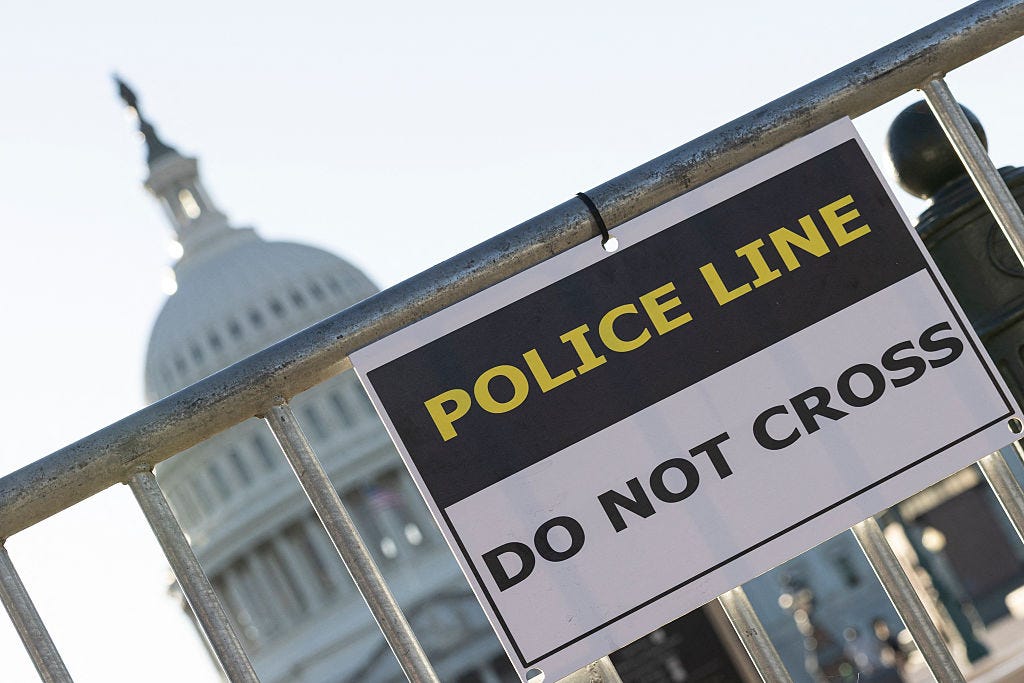Armageddon in the Civil Service
Under cover of the government shutdown, Trump is stretching presidential powers even further by firing thousands of workers.

This article is part of an ongoing project by American Purpose at Persuasion on “The ‘Deep State’ and Its Discontents.” The series aims to analyze the modern administrative state and critique the political right’s radical attempts to dismantle it.
To receive future installments into your inbox—plus more great pieces by American Purpose and Francis Fukuyama’s blog—simply click on “Email preferences” below and make sure you toggle on the buttons for “American Purpose” and “Frankly Fukuyama.”
What would happen if Armageddon came and hardly anyone noticed? The 1998 Bruce Willis movie of that name was boffo at the box office, but the Trump firing of feds on October 10 slipped by with surprisingly little attention.
That day was an Armageddon in the relatively short life of the Trump administration. It was a fundamental challenge to the constitutional separation of powers, but it disappeared in the dust of a very big news weekend that featured the peace deal in the Middle East.
Taking advantage of the government shutdown, the administration fired more than 4,000 employees, a move that slipped by most of the media. The next morning, in fact, CNN’s roundtable debated President Trump’s snub by the Nobel Peace Prize committee. That was the easy headline, because the fed-firing Armageddon was much less salacious and much more difficult to unpack.
So why is this an Armageddon—and why has it been mostly invisible?
The second question is the easiest to answer. Since its very first hours, the administration has brushed back the boundaries on virtually every bit of presidential power. Firing a few thousand more federal employees seemed like just a blip on an already crowded radar screen.
It’s the first question that matters most. At the beginning of the weekend, Russell Vought, Director of the Office of Management and Budget (OMB), posted on X, “The RIFs have begun.” The start was another round of layoffs—“reductions in force,” or RIFs—but this time there were two new features. One was the administration’s explicit political targeting. Trump was asked whether the firings were politically motivated. Absolutely, he said. They would “be Democrat-oriented because we figure, you know, they started this thing” (“this thing,” of course, being the government shutdown.) “So [the firings] should be Democrat-oriented. It’ll be a lot.”
In fact, the president said he’d cut “the most egregious, socialist, semi-communist, probably not full communist” programs as part of his continuing campaign to slash programs by cutting their employees.
The administration viewed the first round as just a start. Four days later, the OMB said it was “making every preparation to batten down the hatches and ride out the Democrats’ intransigence.” It pledged to “continue the RIFs.” Trump said that he was going to continue to target programs that Democrats supported and that “they’re never going to come back, in many cases.” To underline the point, Trump posted an AI-generated video on Truth Social featuring Vought as the grim reaper (without apology to—or the permission of—the musical group Blue Öyster Cult, whose music provided the soundtrack for the video).
And in his most telling note, Trump said at a White House event, “We’re being able to do things that we were unable to do before.”
The Wrath of Armageddon
In terms of style, there are lots of new things about this government shutdown, including the vitriol coming from top figures and a more experienced hand at strategy, thanks to lessons from previous long shutdowns. But even more fundamentally, what’s different is a conscious strategy of using the shutdown to work around the constraints on the president that come from the Constitution’s balance of powers. Congress can’t approve a new budget. No budget, no money. No money, no government functions—except for essential services, which the OMB, conveniently, can define on its own. No designation of “essential,” and the administration figures it can simply end programs, agencies, and employees who used to run them.
In what had passed for normal times, Congress created programs and funded the people to implement them. In this shutdown, the Trump administration has played the reverse game. No funds for the people—just write them and tell them that their services are no longer needed.
For the administration to kill a program, it used to need Congress’s say so. In this shutdown, without a budget, the Trump administration is killing programs and functions simply by draining them of the people needed to run them. Getting legislation to close down a program, as we learn over and over again, is messy because the affected constituencies circle to defend themselves. The shutdown version of killing programs is much cleaner. It cuts Congress and the public out of the decision, and then empowers the president and his budget chief to make the decisions.
Why go through the tough debates about cutting programs (which rally supporters on Capitol Hill), closing down agencies (which is even tougher), or impoundments (which are illegal, the Government Accountability Office has ruled), when Trump claims the power to make a one-stop shop: simply gut a program by firing feds, without the inconvenience of the separation of powers?
It’s a handy formula. In one area that suffered big cuts, the former director of a CDC center said sadly, “CDC is over. It was killed.” He added, “This administration only knows how to break things. They have made America at risk for outbreaks and attacks by nefarious players. People should be scared.” But the administration wasn’t, and few people noticed. The administration’s sustained attacks on the CDC hit their mark. A September 2025 Gallup roll showed that the public’s rating of the CDC had fallen by one-fourth in the last year, to a level just barely higher than the IRS. What had once been hailed as the world’s best public health agency was in shambles.
Can He Do That?
It’s possible to answer this question in two ways. One is to have an academic debate around the principles and history of administrative law. That’s mighty interesting, but it doesn’t put points on the board (or score cuts in the federal workforce).
The other is to reckon with an inescapable reality of the American constitutional system: each of the three branches has only the powers that the other branches are prepared to surrender to it.
And here’s where the problems march in. As I write this, the House has been AWOL—literally—for 26 days, since September 19. It’s impossible to have a check if no one is around to enforce a balance.
As for the judiciary, there are (at least) three problems. One is that the administration has moved so far, so fast, that it’s been hard for anyone to keep up. It’s a flood-the-zone strategy that the Green Bay Packers have used with great success: overload the field with receivers on one side of the field and bet that the defense won’t be able to keep up. (Full disclosure: I’m an owner of the Green Bay Packers, along with 538,966 others.) The more cases the administration stirs up, the harder it is for litigants to challenge its actions and for the courts to hear the cases.
The second is that the president enjoys an inherent amount of deference because of the “presumption of regularity”—that he has the power to do what he does unless someone can prove otherwise. Combating Trump on these grounds means digging into the details of the procedures used in making decisions, and that can be tough and time-consuming, by which point, the administration is already three more decisions down the road.
The third is the argument that the administration makes about inherent “unitary executive” powers. It’s the “’cause I say so” argument. Article II of the Constitution says, “The executive Power shall be vested in a President of the United States of America.” This “vesting clause,” a single sentence in the Constitution, is “causing America huge problems,” New York Times columnist David French contends.
So, just what is the “executive Power”? Well, it’s what the president says it is “’cause I say so”—until Congress or the courts say otherwise. And with Congress out of town and the justices of the Supreme Court trying to figure out how to deal with the hot potato that the president who appointed them is tossing their way, the “’cause I say so” argument is going to stick, at least for a while.
The Whisper in the Wind
Sooner or later—probably later than sooner—Congress will find a way through the impasse it brought on itself. Sooner or later—certainly later than sooner—the Supreme Court will wrestle with the challenge of deciding where the fences around the president’s power ought to be.
It’s inconceivable, however, that these decisions will put the constitutional balance of powers back to where they were in mid-September of this year, let alone September 2024. We’ve entered a realm dominated by the presumption of irregularity, and by Trump’s skill (more precisely, the skill that Vought and the administration’s top attorneys bring to the issue) in stretching presidential power far beyond where it had been before.
Just since January, we’ve seen the federal workforce take a hit of 154,000 employees who took the “Fork in the Road” offer of a “deferred resignation,” agreeing to resign back in February in exchange for a promise to pay them through the end of September. At least another 51,000 employees had been laid off before October 10. Then there are the 4,000 fired in October. That totals about 210,000 employees—and the numbers are rough, because the administration has released very few solid statistics, keeping the full impact of its work a whisper in the wind.
This is a lot of people—a bit more than 9 percent of the federal workforce. And the administration isn’t done yet, Trump promises.
And all of this came through strategies and tactics either unknown or untested before January 20, 2025. The closest a previous administration had come was during the Nixon years. Nixon and his team dreamed of this kind of power, but they never dared try it and, even in their dreams, they never imagined pushing things this far.
The mass firings drain the federal government of the talent it needs to run the programs that Congress has created. It makes it increasingly impossible to recruit the workers the government will need in the future. Who, after all, would want to bet their careers on a job that could instantly vaporize on the whim of the boss?
Even worse, it encourages everyone in the political system to see every step in purely partisan terms. On one hand, of course, every policy decision has partisan overtones. It’s often said that “there’s no partisan way of filling a pothole,” but that’s not true. Which neighborhoods get attention first when it comes to filling potholes, paving sidewalks, and plowing snow is an inherently political decision. That’s one thing. But framing every decision through a deeply partisan lens is what fed the party machines of a century and a half ago, and that didn’t go well, either for problem solving or for the American people.
Trust in government is mighty hard to build, but a Gallup poll, released just before the 4,000-person cuts, shows how easy it is to destroy it. Trump’s attacks on the CDC, CIA, IRS, FDA, FEMA, and EPA have driven the public’s trust for all of these agencies into the ground.
In Federalist 70, Hamilton famously argued, “A feeble Executive implies a feeble execution of the government.” Firing feds is a quick road to enfeeblement—and undermining trust in the government that’s left.
But how to control that power? The last thing the Founders wanted was to recreate George III on this side of the Atlantic. So Madison, in Federalist 58, wrote about Congress’s power of the purse, which “may, in fact, be regarded as the most complete and effectual weapon with which any constitution can arm the immediate representatives of the people.”
Congress has been firing blanks. The purse is empty. The Supreme Court has been unable to unzip it or determine how deeply the president’s hands can reach into it.
And Trump has maneuvered through all these institutions to create a constitutional Armageddon whose costs will last long past this shutdown—and, indeed, far into the nation’s future, past the 250th anniversary of the Declaration of Independence next year, which we’ll celebrate with a mixed martial arts fight on the White House grounds.
Donald F. Kettl is Professor Emeritus and Former Dean of the University of Maryland School of Public Policy. He is the author, with William D. Eggers, of Bridgebuilders: How Government Can Transcend Boundaries to Solve Big Problems.
Follow Persuasion on Twitter, LinkedIn, and YouTube to keep up with our latest articles, podcasts, and events, as well as updates from excellent writers across our network.
And, to receive pieces like this in your inbox and support our work, subscribe below:






